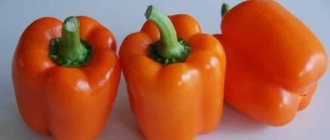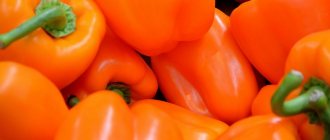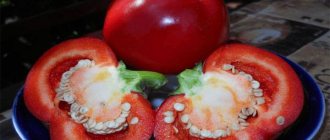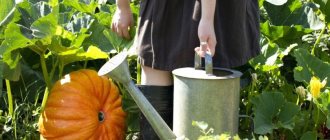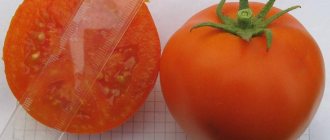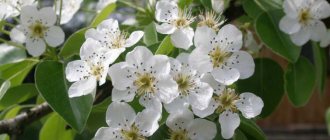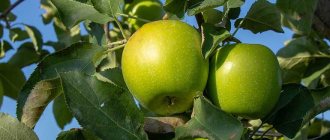Early varieties of sweet peppers are suitable for growing in temperate climates. These include the Fakir pepper, which according to its characteristics and description falls into the group of early ripening peppers, and, according to photos and reviews from summer residents, it is also very productive. The variety is unpretentious in care, grows in shelters and on ridges, with excellent taste. For regions of risky farming - one of the best options.
Description and characteristics of the variety
The plant is of medium foliage, with strong stems. The height varies, outdoors on ridges the bushes grow up to 50-60 cm, in greenhouses - up to 110-130 cm.
The leaf blades are wide, slightly wrinkled, rich green in color, on long, fragile petioles. The peppers are small, cone-shaped, elongated, drooping. At the stage of technical ripeness they are yellowish with an orange color, when fully ripe they are burgundy-red.
Find out what to do if your pepper won't turn red.
Length – up to 12 cm, weight – 60-80 grams. When bushes and ovaries are formed, larger specimens are obtained, weighing up to 180-200 grams. The skin is dense, glossy, the pericarp is up to 4 cm. Inside there are usually 2-3 chambers, there are few seeds.
The taste is pleasant, with a characteristic sweetness and piquant aroma. They are mainly used fresh, dried and ground into powder for seasonings, and frozen. Fakir fruits are tasty in slices and are suitable for preparation.
On a note! Breeders have developed Fakira varieties with brown, yellow and almost black fruits.
Peppers harvested in an unripe state are suitable for storage. Fully ripened fruits on the bushes are quickly processed.
Growing "Fakira" seedlings
Due to the fact that this variety is early ripening, seedlings should be planted in open ground in the warm period of the year, when the ground is well warmed up. This variety is also intended for planting in greenhouses. Planting of seedlings can be done when the height of the seedlings reaches 12-20cm.
It is important to know! On average, the total period of time from the beginning of seed germination to the appearance of the first fruits ranges from 105 to 120 days.
Due to the fact that bell peppers came to us from Central America, where the climate is warm, it is therefore worth growing it in warm climates with plenty of light, sun and fertile soil. The most suitable regions for growing bell pepper “Fakir” are: Southern Russia, Ukraine, North Caucasus, Central Asia, Primorsky Krai, Transcaucasia. If weather and climatic conditions do not allow pepper to be grown in open ground, then “Fakir” bell pepper can be grown in greenhouse conditions. The most acceptable air temperature for growing pepper is +23...+26C. Before planting peppers, the soil should be fertilized; for this you can use: sawdust, compost, peat, manure.
Planting seedlings of “Fakir” pepper in the ground
When planting “Fakir” pepper seedlings in the ground, it should be watered generously. If seedlings are planted in cool soil, it is necessary to apply fertilizer to improve plant growth and quickly get used to the soil. During the growth period, as well as during the hot and sultry summer period, watering the plant must be done daily in the evening. Thus, the roots of the plant will be saturated with moisture and there will be enough moisture until the next watering. In addition, during the period of fruit ripening, moisture is simply necessary and then the Bulgarian “Fakir” will delight you with beautiful and juicy fruits.
Advantages and disadvantages
The Fakir variety belongs to the sweet peppers of Siberian selection. Bred specifically for regions with short summers and a temperate climate, it is suitable for planting in Siberia, the Urals, regions of the North-West of the country, as well as in the middle zone.
Valued for a number of qualities:
- high yield. Despite the small size of the fruits, in general it produces a good harvest of pepper (3-4 kg per bush);
- disease resistance;
- unpretentiousness;
- ability to withstand adverse weather conditions well;
- high quality fruits, excellent taste;
- good commercial properties;
- early ripening (90-110 days depending on cultivation conditions);
- suitability for transportation;
- short period of transition from the stage of technical to biological maturity.
There is no specific information on shortcomings. Many summer residents grow Fakir pepper and note that the fruits are not very large. But for lovers of thick-walled and large peppers, it is recommended to select other varieties.
Choosing a sweet pepper variety when planting
When choosing seeds, you need to take into account some important factors that affect growth and yield, namely:
- Climatic zone and weather conditions for growing.
- Tall or low growing varieties.
- Desired color and shape of the fruit.
- Variety type (early ripening – late ripening).
- Type of planting (open bed or greenhouse).
It is better to plant tall varieties if the bed is large. If there is not much space, you should focus on low-growing varieties. When purchasing seeds, the name of the variety and growing conditions must be indicated on the package. “Fakir” will feel great in small beds and will not require staking of the stem during fruiting, as it is a low-growing variety.
Features of agricultural technology of the variety
The cultivation scheme for Fakir pepper is standard. They start with preparing seeds for sowing and growing seedlings. The variety is not particularly suitable for the southern regions, as it does not tolerate long hot periods.
Growing seedlings
When using purchased or your own seeds, be sure to:
- calibration;
- disinfection (in a pinkish solution of potassium permanganate for no more than 20 minutes);
- germination in damp tissue.
A number of gardeners harden seeds, but it all depends on the availability of time and desire. According to the experience of many summer residents, it is enough to disinfect the seeds and germinate them until they swell and sprouts appear.
Sow in common seedling boxes followed by picking or directly into separate cups. Peppers do not tolerate transplantation well, so it is better to take care of a separate container. Temperature for growing - within +22ºC...+25ºC with air humidification.
Landing dates are the end of February and the first ten days of March. Seedlings need lighting, for which they use phytolamps or fluorescent lamps.
On a note! Incandescent lamps are not suitable for lighting. They heat up the plants and also produce the wrong spectrum of radiation.
Water the pepper seedlings over the ground, gently moistening the soil. If the seedlings grow in fertile soil, you can do without fertilizing during the seedling period. When the growth of bushes slows down or there is a nutritional deficiency, they are fed with special compounds (Kemira Plus, Kemira Universal, Agricola) or complex fertilizer.
When the first bud appears at the fork of the stems, it is recommended to remove the ovary. This helps to increase the number of flowers and ovaries higher in the tiers of the plant, increasing the overall yield.
10-14 days before transplanting to beds or shelters, peppers begin to harden. They take it out onto the balcony, onto the veranda, starting from 5-10 minutes and gradually increasing the time to several hours.
Hardening will help avoid stress in plants and eliminate the risk of stunted growth.
Disembarkation
Plants are planted when the soil warms up to +16ºC and stable heat is established. When grown in greenhouses in the middle zone, Fakir is ready for planting in mid-May, in the northern regions - no earlier than the beginning of June.
Planting scheme: 4 bushes per square meter. The variety grows well in greenhouses and tunnels, but ventilation is required. At high temperatures, the ovaries and leaves fly off.
Watering
Water the plants 2-3 times every 7-8 days, adjusting soil moisture levels. The first watering is 8-10 days after planting. During this time, the roots adapt to new conditions, and the plant gets stronger. It is advisable to prepare mulch in advance and add soil near the bushes.
Suitable mulch:
- cut chopped grass;
- rotted compost;
- peat;
- sawdust.
Mulch retains moisture in the soil, prevents drying out and at the same time removes excess liquid. Drip irrigation is effective, allowing you to normalize the volume of water in the soil.
The watering rate for an adult pepper bush is 2-3 liters.
Feeding
During the growth of pepper in a permanent place, it is enough to feed the plants with fertilizers 2-3 times. First, before the stage of mass flowering, nitrogen fertilizers are used (diluted mullein, poultry droppings), then, at the beginning of fruit formation, priority is given to potassium and phosphorus.
On a note! Exceeding the dose of nitrogen in fertilizing increases the growth of vegetative mass and reduces the number of ovaries.
To increase productivity, ready-made formulations are used:
- GUMI;
- Kemira-Lux;
- Crystal.
Fertilizers Uniflor-Rost, Agricola, Aquadon-Micro are also suitable for peppers.
Adding banana peels to the soil, watering peppers with ash infusion, and superphosphate extract are effective. All these compounds help improve pepper immunity and good growth. The fruits set faster and ripen immediately on the bushes.
Formation of bushes
The Fakir variety is medium-sized, so it does not require special shaping of the bushes. Remove:
- the first flower at the fork of the stems;
- yellowed leaves;
- several lateral branches with strong density.
Closer to August, some of the flowers are removed so that all the peppers on the bush have time to form and ripen.
Growing and care
Peppers require systematic, simple care. Humidification is carried out 7-10 days after transplantation. The time for watering is in the evening or in the morning before it gets hot. The water must be heated. Before flowering, the frequency of watering is from 1 to 2 times a week. When flowering and ripening, peppers are watered up to 2-3 times a week.
The moisture rate per 1 m2 varies between 6-10 liters per 1 m2 (corresponds to the humidity level in the beds).
Place the culture in well-lit areas. After planting in a permanent place, they need systematic moisture and nutrition (organics and minerals).
The frequency of application of fertilizers is 3-4 times per season. The root and leaf methods are used. After flowering, potassium salts (Kaliyvit, potassium sulfate) must be used.
The plants are formed into 2 trunks, the stepsons and the crown bud are pinched. As it grows, remove yellowed leaves. Tall stems in greenhouses are fixed to trellises.
Disease prevention and pest control
This variety of sweet pepper is considered resistant to infections. It is enough to follow simple rules of agricultural technology:
- disinfect seeds before sowing;
- alternate planting peppers in a greenhouse with other crops;
- plant bushes according to the scheme, maintaining distances;
- Avoid strong temperature changes, dense plantings, and high humidity in the shelter.
Dusting the soil with ash or tobacco dust helps against slugs; to prevent the appearance of spider mites, plants are sprayed with an infusion of garlic, dandelion or wormwood.
Resistance to diseases and pests
Fakir pepper is generally resistant to diseases. However, even the most resistant variety can get sick if you do not pay at least minimal attention to it and do not follow the basic, simple rules of agricultural technology.
Diseases: pepper can be affected by fungal infections, especially if it grows in closed ground and lacks air, heat, light, if there is an excess of moisture, or low temperatures. Periodic spraying with fungicides or decoctions and infusions of sanitary herbs will help against fungal diseases. Pepper can also be affected by fungal diseases in open ground, if it grows in the shade, it does not have enough sunlight, if the summer is too humid, rainy, and the plantings are dense.
May be interesting Pepper “Ali Baba”: a variety with universal cultivation Zorachka potatoes: description and characteristics, reviews Pepper “Giant F1”: colorful and attractive
To prevent peppers from getting sick, you should create the necessary conditions for them to grow and bear fruit:
- maintain the distance between bushes;
- ventilate greenhouses regularly;
- do not allow waterlogging, water regularly, but moderately;
- observe temperature and light conditions; if there is a lack of light, supplement the plants with special phytolamps;
- do not plant pepper seedlings in the shade;
- greenhouses or other indoor premises should be kept clean; in the fall, after harvesting, remove plant residues, dig up the soil, disinfect, fumigate the room with sulfur bombs;
- observe crop rotation.
It is better and easier to apply preventive measures, to follow the necessary rules of agricultural technology for a given crop, than to then try to fight diseases and treat diseased plants.
Pests: The main pests that threaten peppers are aphids, mites and slugs.
To save peppers from aphids, it is useful to spray the bushes with soap solutions, tobacco tincture, or a soap solution with the addition of ash.
Spraying with a solution of onion, garlic and dandelion helps against spider mites: one glass of chopped onion, garlic and dandelion leaves per 10 liters of water. Dilute the entire glass in water and leave for about a day. Add soap to the strained infusion (so that the solution stays better on the leaves) and spray the bushes.
Grate laundry soap on a fine grater and dissolve in a liter and a half of water. This concentrate can then be added to any infusion, decoction or spray solution to help the composition stay on the leaves longer.
To prevent slugs, it is good to dig small furrows around the pepper bushes, or sprinkle the soil with lime, ash, or tobacco dust.
